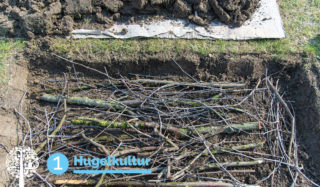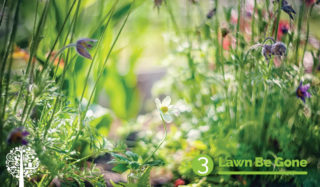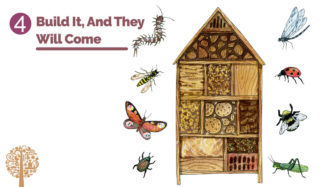With so many negative headlines and extreme weather events these days, it’s easy to feel anxious about climate change. But we can all lend Mother Nature a helping hand through regenerative gardening practices! Whether tending to a large backyard garden or just a few containers on a balcony, you can incorporate various techniques into your gardening regimen that will help sequester carbon and attract pollinators and other wildlife. If regenerative agriculture is the way of the future, then we’re all in! Join us by giving one or all of the following tips a try in your home garden.
Hugelkultur
It’s cheap and easy on the back; no wonder hugelkultur is taking off in home gardens everywhere! This no-dig technique has been around for centuries and is a tried and true regenerative growing practice. No need for expensive products or inputs; hugelkultur involves building garden beds by recycling woody debris and other natural materials you already have lying around the house, such as logs, branches, fallen leaves, grass clippings, and old newspapers. You’ll create your garden by layering all of these items, like lasagna. Start with a log pile between one and three feet tall and cover it with a layer of nitrogen-rich material, like grass clippings, compost, seaweed, or aged manure. This layer jumpstarts the log decomposition. Finally, cover your garden with 6-12 inches of hay, straw, wood chips, or shredded leaves to help with water retention. Your garden will slowly break down over time while feeding your plants the nutrients they need. You can feel good about recycling naturally decomposing materials, using less water, storing carbon, and more! If you’re short on space, this method works just as well in containers, so no excuses.
Check out this blog for more hugelkultur gardening tips!
Build Native Gardens
Doing things that are out of the ordinary keeps life interesting, but when it comes to your outdoor home garden, stick to the ordinary. In other words, don’t go crazy selecting unique plant and flower varieties; native plants are always best, especially in regenerative gardens where reducing your carbon footprint is critical. Flowers, shrubs, and ground covers native to your agricultural zone will better handle the region’s weather conditions, be more resistant to pests and diseases, and are low-maintenance. They don’t require a lot of watering, fertilisers, or chemical sprays of any kind, making these cottage-style gardens a super eco-friendly option for us all. Better yet, local wildlife, pollinators, and other beneficial insects love them; all the more reason to stick with varieties your region knows.
Lawn Be Gone
Grass that looks like a putting green has long represented the quintessential yard, but regenerative gardeners are shaking things up with horticultural disobedience. Take a walk on the wild side by replacing turf grass with wildflowers, clover, ornamental grasses, and other ground covers. Bees, butterflies, and birds will come to your property in droves, and you’ll be able to take it all in because you won’t be busy mowing, watering, or spraying the lawn. Good times! If you’d still like to sow a more typical lawn, look for bags of seed offering hardy plant mixes rather than one single variety of grass. They might cost more upfront, but you won’t spend as much money or time maintaining your lawn down the road. Allow lawn plants to go to seed before mowing, offering pollinators plenty of clover and dandelions to enjoy. It’s all about tweaking the vision of what our homes and gardens should look like; while cookie-cutter residential lawns have been the idea of perfection for years, it’s time to start accepting that our yards should be perfectly imperfect. It’s also an excellent opportunity to let your inner rebel loose. You’re so bad.
Build It, And They Will Come
Insect hotels are an interesting feature to add to any garden, regardless of type or size. They’re visually appealing and offer beneficial bugs a safe spot to hibernate for the winter. Then, when temperatures warm up, they’ll come out and head straight into your garden, giving you a leg up on pollination for the season! You can purchase pre-made bug hotels at your local garden centre, but there are also plenty of easy DIY project plans in gardening books or online. Another awesome garden feature is a homemade worm hotel. In her book, The Regenerative Garden, Stephanie Rose describes a worm hotel as a combination of spot composting and a vermicompost bin buried in the soil. Ideal for small spaces, the hotel creates a space for worms to break down organic matter for your plants to enjoy. All you need is a tube or bucket that’s open at the bottom and can be closed with a lid at the top. Place the hotel in a spot that will benefit from extra nutrients; backfill around the outside so that only about three inches are above the ground. Fill the inside with bedding material such as dried leaves, shredded paper, or straw, and then add some fresh compost to dampen the carbon material. Top the compost with 200 composting worms and regularly feed them vegetable kitchen scraps. Cover them with more bedding material, and you’ll be well on your way to the richest compost possible in no time!
Healthy Soil = Healthy Plants And Vice Versa
The most basic principle in regenerative/organic gardening is creating a healthy environment for plants to grow. There’s no need for chemical inputs of any kind; if your soil is healthy, your plants will follow suit and be less prone to pests and disease. Amend soil with compost and green manures like clovers, hairy vetch, and mung bean. Make homemade compost with kitchen scraps, or buy the best you can afford from a nursery. They call it ‘black gold’ for a reason; organic matter and microorganisms work together to create an aerated, nutrient-rich soil that retains moisture without becoming too wet. Protect that beautiful earth from washing away or becoming overgrown with weeds by mulching between and around plants. Mulch is also essential for keeping soil temperatures consistent and preventing water evaporation. No need to purchase anything expensive; natural materials such as wood chips, shredded leaves, straw, and grass clippings do the trick. When you nurture your soil, you nurture your plants and vice versa. Begin with this in mind, and the rest will fall into place.




